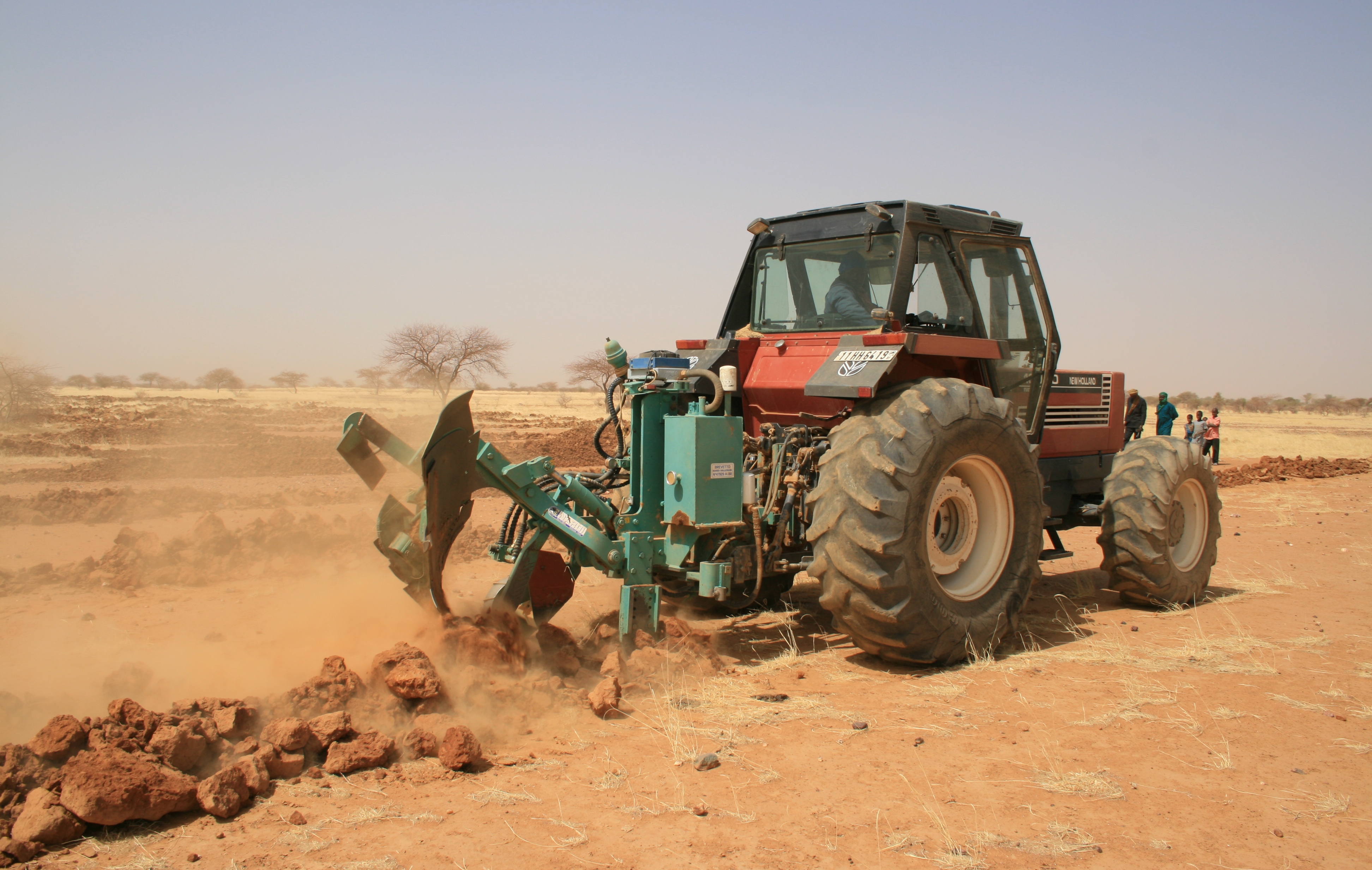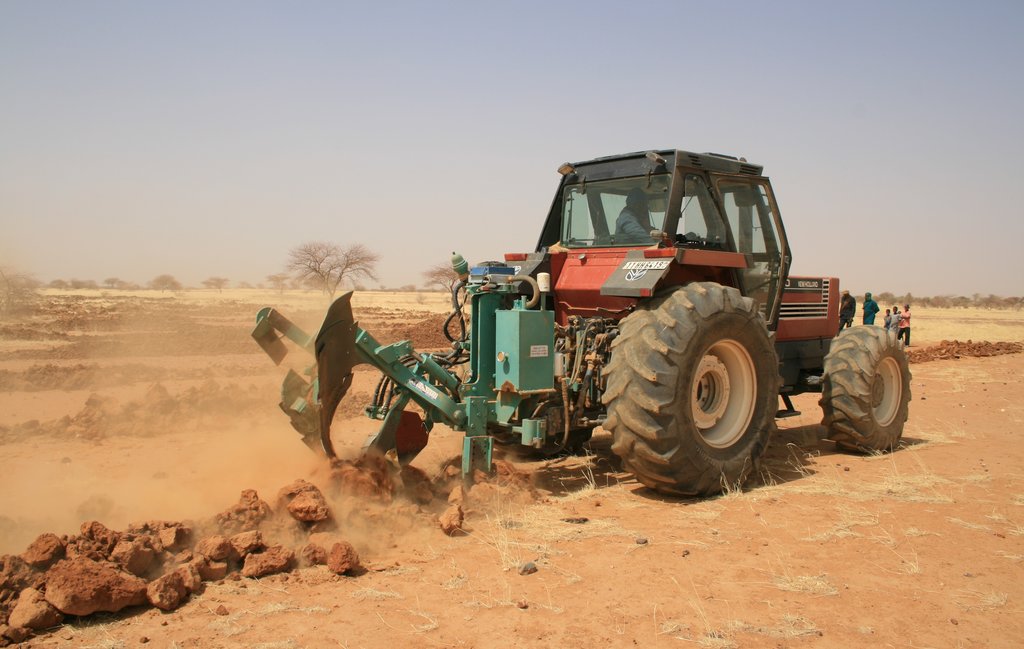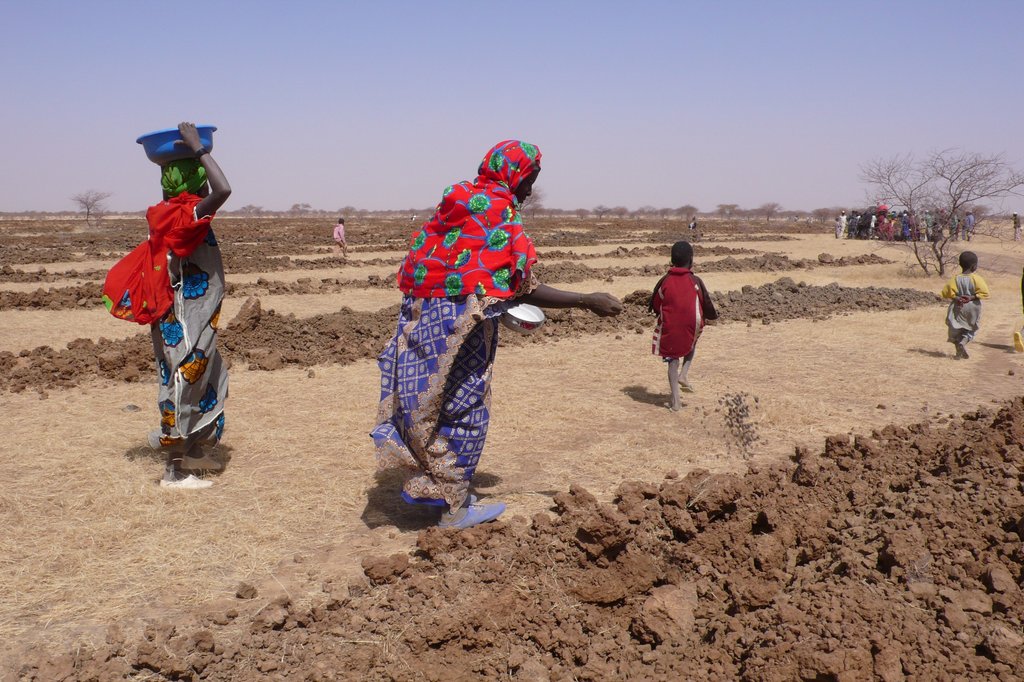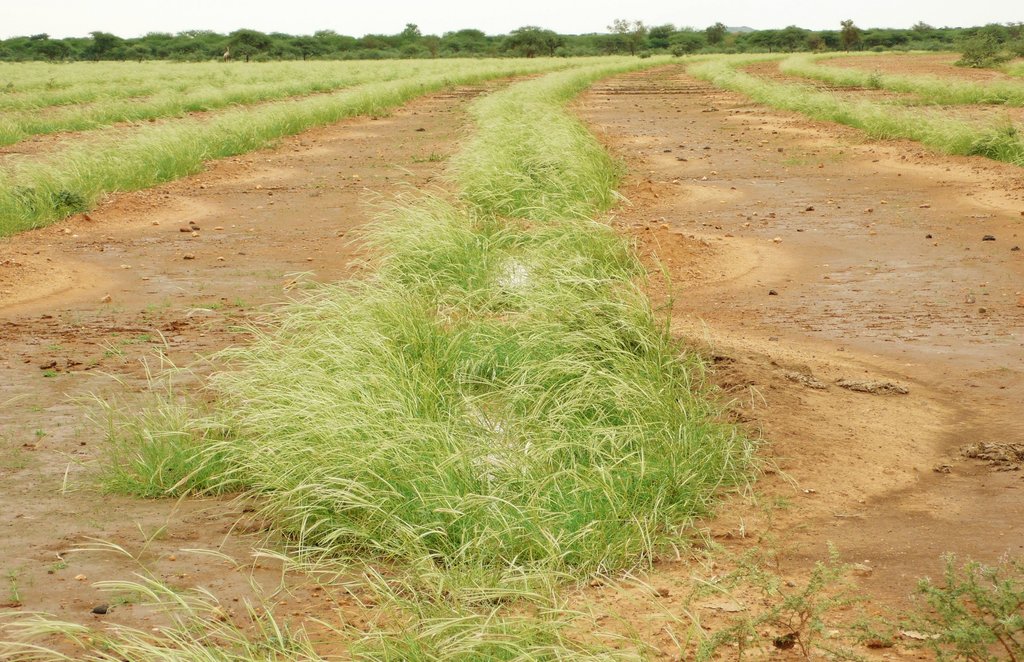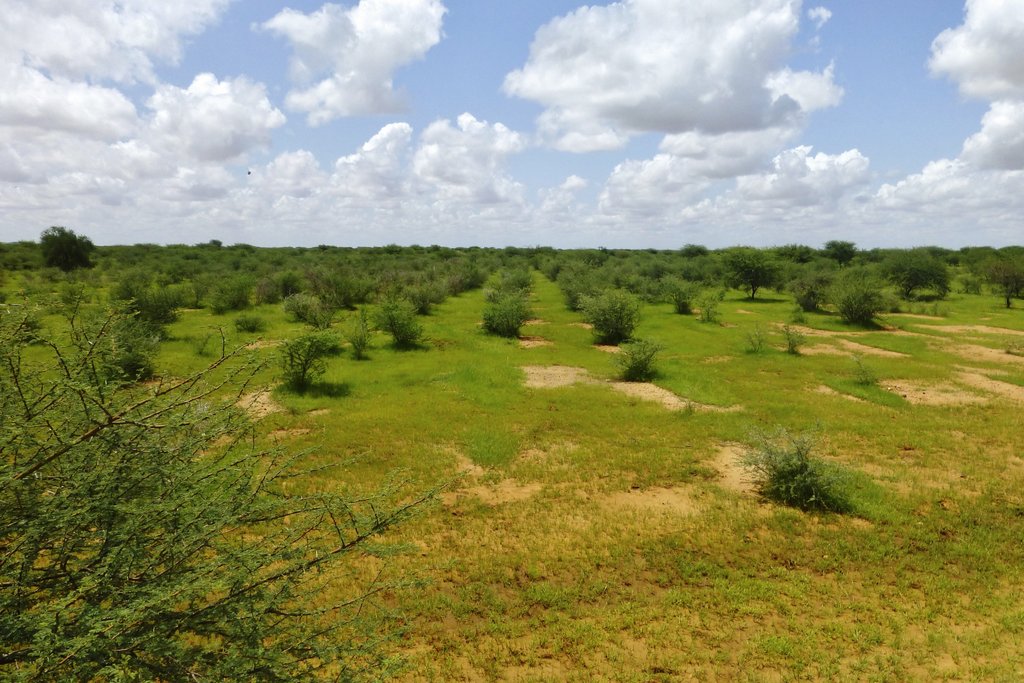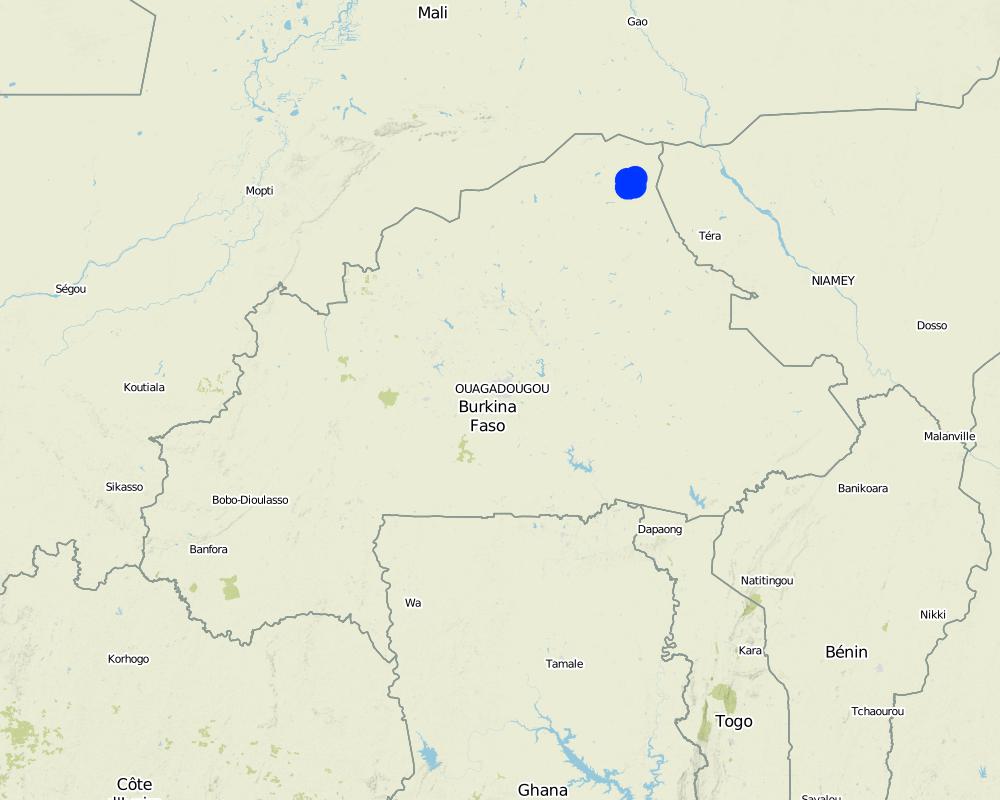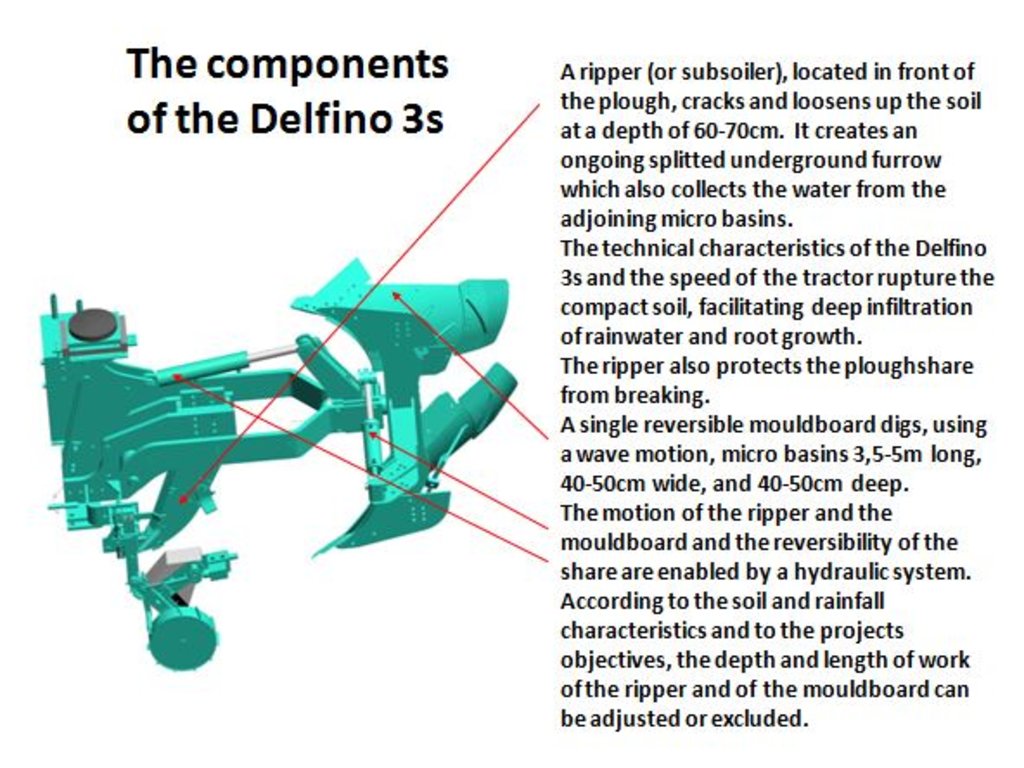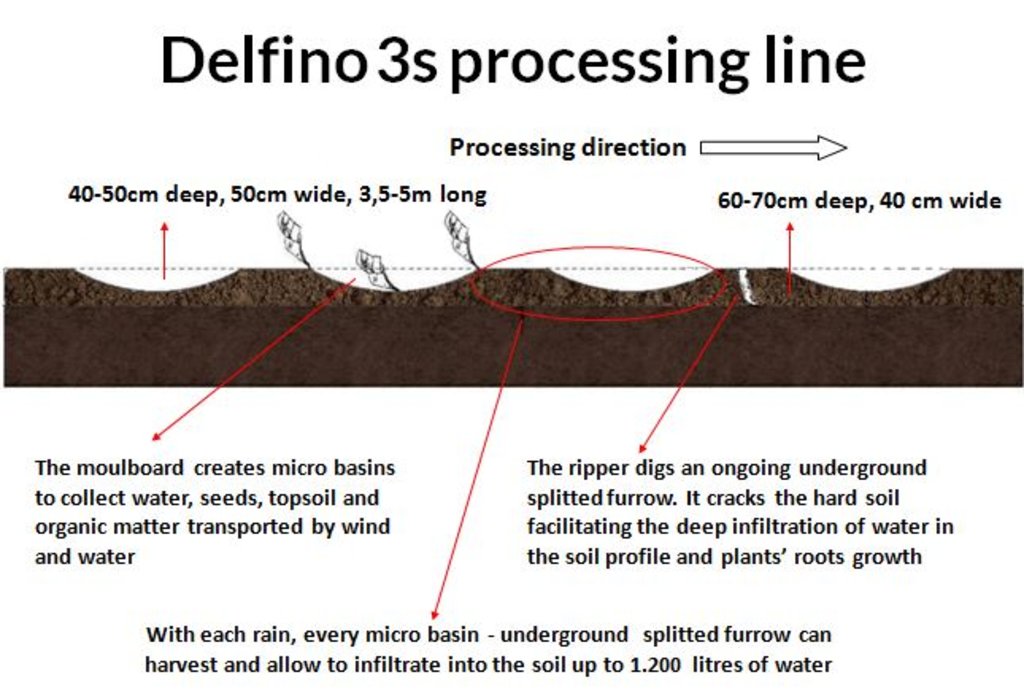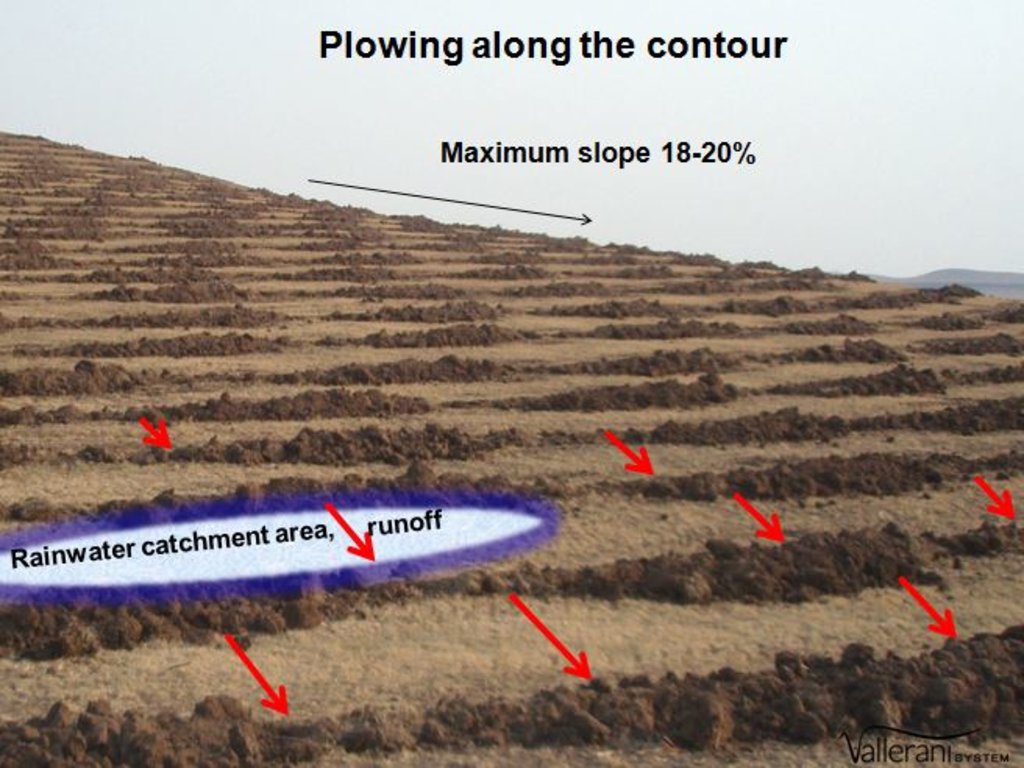Vallerani System [بوركينا فاسو]
- تاريخ الإنشاء:
- تحديث:
- جامع المعلومات: Sabina Galli Vallerani
- المحرر: –
- المراجعون: Donia Mühlematter, Rima Mekdaschi Studer
technologies_1528 - بوركينا فاسو
- Vallerani System: 16 يوليو، 2018 (inactive)
- Vallerani System: 16 يوليو، 2018 (inactive)
- Vallerani System: 12 يوليو، 2018 (inactive)
- Vallerani System: 15 أغسطس، 2018 (inactive)
- Vallerani system: 4 إبريل، 2018 (inactive)
- Vallerani system: 4 يناير، 2017 (inactive)
- Vallerani System: 30 سبتمبر، 2020 (public)
- Vallerani System: 8 مارس، 2019 (inactive)
عرض الأقسام
توسيع الكل طي الكل1. معلومات عامة
1.2 تفاصيل الاتصال بالأشخاص الرئيسيين لمصدر المعلومات والمؤسسات المشاركة في تقييم وتوثيق التقنية
مستخدم الأرض:
Long Allain
Reach Afrique, NGO
بوركينا فاسو
متخصص في الإدارة المستدامة للأراضي:
Lindo Grandi
Deserto Verde Burkinabé, NGO
سويسرا
مستخدم الأرض:
Boureima Amadou
Reach Afrique
بوركينا فاسو
اسم المشروع الذي سهّل توثيق/تقييم التقنية (إذا كان ذلك على صلة)
Book project: Water Harvesting – Guidelines to Good Practice (Water Harvesting)اسم المؤسسة (المؤسسات) التي سهلت توثيق/تقييم التقنية (إذا كان ذلك على صلة)
Reach Africa (Reach Africa)اسم المؤسسة (المؤسسات) التي سهلت توثيق/تقييم التقنية (إذا كان ذلك على صلة)
Reach Italia (Reach Italia) - إيطاليا1.3 الشروط المتعلقة باستخدام البيانات الموثقة من خلال WOCAT
متى تم تجميع البيانات (ميدانيا)؟:
2012/2018
يوافق جامع المعلومات والشخص (لاشخاص) الرئيسي لمصدر المعلومات على الشروط المتعلقة باستخدام البيانات الموثقة من خلال WOCAT:
نعم
1.4 إعلان بشأن استدامة التقنية الموصوفة
هل التقنية الموصوفة هنا تمثل مشكلة فيما يتعلق بتدهور الأراضي، بحيث لا يمكن إعلانها تقنية مستدامة لإدارة الأراضي؟:
كلا
2. وصف تقنيةالإدارة المستدامي للأراضي
2.1 وصف مختصر للتقنية
تعريف التقنية:
A special tractor-pulled plow that constructs micro-catchments. It combines the traditional techniques of rainwater harvesting with mechanization for large scale land rehabilitation.
2.2 وصف تفصيلي للتقنية
الوصف:
The Technology mechanizes the traditional technique of zai and semi circular bunds for water harvesting using a modified plow named Delfino3s pulled by a 180hp tractor. A normal plow on flat land excavates a symmetrical, continuous furrow, and earth piles up equally on both sides of the furrow. The Delfino3s plow has a single reversible plowshare that creates an angled furrow and piles up the excavated soil in half moon shaped ridges only on the downhill side. The plowing must be done along the contour to collect and slows down runoff water as it flows downhill. The plow’s blade moves in and out of the soil creating micro basins about 5 meters long, 50 cm deep, 50 cm wide and spaced 2-3 m. The ripper placed before the plow cracks up the soil to a depth of 70 cm facilitating the infiltration of water into the soil profile and the growth of deep roots. After plowing, the local population sows seeds of plants of indigenous species. They are sown along the ridges of the basins and in the furrow of the ripper. While for most species seeds are collected by the local population, for species rarely present in the region, seeds are purchased from tree nurseries. Sowing the manure of goat containing seeds has also been very successful with about 95% of all micro basin having at least one tree growing. The intervention on a big scale, the effects of water infiltration in depth, erosion reduction and vegetation growth, boost a long lasting rehabilitation process. Each day the Delfino plow can plow up to 20 ha, digging 6.000-7.000 micro basins. The speed, the capability to plow hard, abbandoned land, the effectiveness of the Delfino3s plow are its major advantages for the ecosystem rehabilitation process but require a big commitment. To make the best out of it, a great motivation and organizational work is necessary to: find great availability of land; train accuratelly the technicians; have well-rooted Subjects in the region. The technological aspect is just part of the recovery process, an important work with the Communities is required upstream and downstream. Communities are involved in the management process – in identifying the areas to be restored, clarifying the land uses of the affected areas, planning and implementing e.g. gathering and keeping seeds of local ecotypes, sowing, in the management of plantations and in the monitoring and evaluation of the results. Rules for SLM are adopted and respected by all. The Technology is applied in a degraded agro-sylvo-pastoral area of the Sahel Region, in the north east of Burkina Faso with 200-500 mm of annual rainfall. The soil is sandy-loam, strongly degraded with surface crust. The population is mainly composed of semi-nomadic herders. At the beginning of the project, the NGO Reach Italia was promoting schooling; they soon realized that during the dry season most kids left school and that to avoid it they should face food security and pasture improvement. So they started applying the Vallerani System and developped the participatory approach. The vegetation growth reduces the need for fodder search and long-range transhumance which also allows children to go to school regularly.The ecosystem rehabilitation effect of the technology help the communities to become more concious and resilient to the effects of climate change and prepared to cope with the socio-economic-environmental changes they are faced with.
2.3 صور التقنية
2.4 فيديوهات عن التقنية
تعليقات، وصف موجز:
A short video that introduces the Vallerani System.The video has been shot in the project area.
التاريخ:
14/05/2014
الموقع:
Oudalan, Burkina Faso
اسم مصور الفيديو:
Jonathan van Laamsverde
تعليقات، وصف موجز:
ICARDA Vallerani –Technology transfer from Morocco to Jordan.
The presentation of the ICARDA Minared project applying the Vallerani System for rangeland rehabilitation in the Jordan Badia.
التاريخ:
16/06/2016
الموقع:
Badia, Jordan
تعليقات، وصف موجز:
REACH – DESERTO VERDE BURKINABe' Vallerani - Recupero Terre in Burkina Faso Sicurezza Alimentare.
Reach Italia and Deserto Verde Burkinabé present the project of soil rehabilitation and food security in Burkina Faso. Italian text.
التاريخ:
01/09/2009
الموقع:
Oudalan, Burkina Faso
2.5 البلد/المنطقة/المواقع التي تم تنفيذ التقنية فيها والتي يغطيها هذا التقييم
البلد:
بوركينا فاسو
المنطقة/الولاية/المحافظة:
Sahel Region
التعليقات:
Since the project is going on since 2002, it is possible to see implemented sites in different stadium of rehabilitation. The plowing lines are clearly visible.
Map
×2.6 تاريخ التنفيذ
في حالة عدم معرفة السنة بالتحديد، يرجى الإشارة إلى التاريخ التقريبي:
- منذ 10-50 سنة
2.7 إدخال التقنية
حدد كيف تم إدخال التقنية:
- أثناء التجارب/الأبحاث
- من خلال المشاريع/ التدخلات الخارجية
التعليقات (نوع المشروع، الخ):
The Technology was introduced in the Region in an agro-sylvo-pastoral pilot project to fight against desertification by FAO in 1996-97.
3. تصنيف تقنية الإدارة المستدامي للأراضي
3.1 الغرض الرئيسي ( الأغراض الرئيسية) للتقنية
- تحسين الإنتاج
- الحد من تدهور الأراضي ومنعه وعكسه
- الحفاظ على/تحسين التنوع البيولوجي
- الحد من مخاطر الكوارث
- التكيف مع تغير المناخ/الظواهر المتطرفة وآثارها
- التخفيف من تغير المناخ وآثاره
- خلق أثر اقتصادي مفيد
- خلق أثر اجتماعي مفيد
3.2 نوع (أنواع) استخدام الأراضي الحالية حيث يتم تطبيق التقنية

أراضي الرعي
أراضي الرعي الواسع النطاق:
- رعي شبه مرتحل
الرعي المكثف/ إنتاج الأعلاف:
- مراعي محسنة
الأنواع والمنتجات الحيوانية الرئيسية:
Goats, cattle.

أرض غير منتجة
حدد:
Hard abbandoned land
ملاحظات:
Especially at the beginning of the project, some communities agreed to try the system on their most unproductive land. After seeing the results, they started to request the intervention on less degraded soil and on fields that are closer to their villages.
التعليقات:
Major land use problems (compiler’s opinion): Land degradation-desertification with reduction of vegetation cover in terms of plant density and species diversity is the main problem: disappearance of grasses and trees, reduction of the size of the plants that are resistant and of the biological activity of the soil. Runoff, water and wind erosion increase. Drought and irregular precipitation have heavy consequences on soil fertility, availability of water for humans and livestock, and recharging groundwater.
3.3 مزيد من المعلومات حول استخدام الأراضي
إمدادات المياه للأرض التي يتم تنفيذ التقنية عليها:
- بعلية
عدد مواسم الزراعة في السنة:
- 1
3.4 مجموعةالإدارة المستدامة للأراضي التي تنتمي إليها هذه التقنية
- الحراجة الزراعية
- الرعي وإدارة المراعي
- حصاد المياه
3.5 انتشار التقنية
حدد انتشار التقنية:
- منتشرة بالتساوي على مساحة
إذا كانت التقنية منتشرة بالتساوي على منطقة ما، فحدد المنطقة التقريبية المغطاة:
- 1,000-100 كم2
التعليقات:
Total area covered by the SLM Technology in the Region is about 25.600 hectares up to 2017.
3.6 التدابير التقنية في مجال إلادارة المستدامة للأراضي

التدابير الزراعية
- A1: الغطاء النباتي/التربة
- A3: معالجة سطح التربة
- A4: المعالجة تحت السطحية

التدابير النباتية
- V1: غطاء من الأشجار والشجيرات
- V2: الأعشاب والنباتات العشبية المعمرة

التدابير البنيوية
- الحواجز والضفاف
- S4: تسوية الخنادق والحفر

التدابير الإدارية
- M1: التغيير في نوع استخدام الأراضي
- M2: تغيير في مستوى الإدارة/الكثافة
- M3: التخطيط وفقا للبيئة الطبيعية والبشرية
3.7 الأنواع الرئيسية من تدهور الأراضي التي تناولتها التقنية

تآكل التربة بالمياه
- الوزن(Wt): فقدان التربة السطحية/تآكل السطح
- (Wg):الانجراف الخلجاني/ الخلجان
- (Wo:) تأثيرات التدهور من مواقع أخرى

تآكل التربة الناتج عن الرياح
- (Et): فقدان التربة السطحية
- (Eo): تأثيرات التدهور من مواقع أخرى

التدهور الكيميائي للتربة
- (Cn): تراجع الخصوبة وانخفاض محتوى المادة العضوية (غير ناتج عن الانجراف)

التدهور المادي أو الفيزيائي للتربة
- (Pc) : تراص التربة
- (Pk)ظهور وتكون قشرة سطحية
- (Pu): فقدان الوظيفة الإنتاجية الحيوية بسبب أنشطة أخرى

التدهور البيولوجي
- (Bc): تناقص الغطاء النباتي
- (Bh): فقدان الموائل
- (Bq): انخفاض الكمية/الكتلة الحيوية
- (Bs): انخفاض جودة وتركيبة الأنواع/التنوع
- (Bl): فقدان الحياة بالتربة

تدهور المياه
- (Ha): التجفيف
- (Hg): التغير في مستوى المياه الجوفية/الطبقة المائية الجوفية
التعليقات:
Main causes of degradation: over-exploitation of vegetation for domestic use , such as wood cut for cooking, to feed livestock or as building material, overgrazing, low contribution of animal dejections that are used as cooking fuel, change of seasonal rainfall, droughts. Secondary causes of degradation: deforestation / removal of natural vegetation (incl. forest fires), low environmental awareness and support services such as forestal or veterinary assistance.
3.8 منع أو حد أو عكس تدهور الأراضي
تحديد هدف التقنية فيما يتعلق بتدهور الأراضي:
- الحد من تدهور الأراضي
- اصلاح/إعادة تأهيل الأراضي المتدهورة بشدة
4. المواصفات الفنية، وأنشطة التنفيذ، والمدخلات، والتكاليف
4.1 الرسم الفني للتقنية
4.2 المواصفات الفنية/شروحات الرسم الفني
Drawing 1) A. The land chosen together with the local population is plowed with the special Delfino3s plow. The spacing between the plowed lines depend on: slope, soil and rain characteristics, purpose of the project. In average the inter-line is 4-6m wide. B. Local people sow seeds (collected from local trees or bought if species are rare) or goat dung containing seeds (collected in the night enclosures after feeding the goats shaking trees with ripe seeds). C. The micro basins collect the rain that falls into the crescents and up to 90% of the runoff water. The water easily penetrates into the soil profile, remains available to plant roots without risk of evaporation and eventually infiltrates to the groundwater. Drawing 2) All plowing measures are adjustable. Total length of work: 4/8 m. Tractor required: 180hp. Working speed: 4/7 Km/h which correspond to 1,5/2.5ha per hour. Weight of the plough: 1800 Kg. Drawing 3) To optimize run off harvesting and reduce water erosion, the ploughing must always be done along the contour. The bare soil between the tilled lines works as catchment area for the collection of runoff. To facilitate the execution of the plowing along the contour, nowadays there are new technologies such as laser guidance systems or GPS assistence.
4.3 معلومات عامة بخصوص حساب المدخلات والتكاليف
حدد كيفية احتساب التكاليف والمدخلات:
- حسب مساحة تنفيذ التقنية
الإشارة إلى حجم ووحدة المساحة:
100 hectares
حدد العملة المستخدمة لحساب التكاليف:
- دولار أمريكي
اذكر متوسط تكلفة أجر العمالة المستأجرة في اليوم الواحد:
2.5
4.4 أنشطة التأسيس
| النشاط | نوع التدبير | التوقيت | |
|---|---|---|---|
| 1. | Project planning, consulting and training | تدابير أخرى | Before starting |
| 2. | Plowing with the Delfino plow | بنيوية أو هيكلية | Dry season |
| 3. | Seed harvesting and storage | زراعية | When seeds are ripe |
| 4. | Missing seeds purchase in local markets or nurseries | زراعية | When seeds are ripe |
| 5. | Direct sowing | زراعية | Dry season |
4.5 التكاليف والمدخلات اللازمة للتأسيس
إذا تحمل مستخدم الأرض أقل من 100% من التكاليف، حدد من قام بتغطية التكاليف المتبقية:
The NGO REACH AFRICA which implements the project is also supported by REACH ITALIA which mainly works for foundraising. They have many different founders. After the first years, thanks to the collaboration and founding by the Swiss Association Deserto Verde Burkinabé and the good results achieved, founders are more likelly to be found. The main are: different NGO's, some Italian Municipalities, a Swiss school, the Gouvernement of Burkina Faso, FAO, international cooperation agencies of Luxembourg and Belgium, a mining company and others.
التعليقات:
The actual (2018) total cost of each implemented hectare is $ 170. This cost can be considerably reduced by around 22% in the case of an optimal use of the Technical Mechanization Unit, ie 800-1000 hours of work per year. This means that an operator who works with the plow Delfino has a gross investment cost which can vary according to its technical and organizational experience and by the amount of the plowed surface each year.
4.6 الصيانة/الأنشطة المتكررة
| النشاط | نوع التدبير | التوقيت/الوتيرة | |
|---|---|---|---|
| 1. | Pasture management to avoid overgrazing | نباتية | After the rain and in the dry season |
| 2. | Vegetation growth management | نباتية | During the first 3-5 years |
| 3. | Woodcut management | نباتية | After 4-7 years |
| 4. | Equipment maintenance (plow, tactor) | إدارية | Daily, weekly, seasonal |
4.7 التكاليف والمدخلات اللازمة للصيانة/للأنشطة المتكررة (سنويًا)
إذا تحمل مستخدم الأرض أقل من 100% من التكاليف، حدد من قام بتغطية التكاليف المتبقية:
The NGO REACH AFRICA which implements the project is also supported by REACH ITALIA which mainly works for foundraising. They have many different founders. After the first years, thanks to the collaboration and founding by the Swiss Association Deserto Verde Burkinabé and the good results achieved, founders are more likelly to be found. The main are: different NGO's, some Italian Municipalities, a Swiss school, the Gouvernement of Burkina Faso, FAO, international cooperation agencies of Luxembourg and Belgium, a mining company and others.
التعليقات:
Maintenance costs of plow and tractor greatly depend from the attention and technical skills of tractor drivers and mechanics and from the diligence and frequency of the maintenance activities of the implements. No other maintenance costs are forseen for the Technology.
4.8 أهم العوامل المؤثرة على التكاليف
قدم وصفا لأهم العوامل التي تؤثر على التكاليف:
Upfront costs for the aquisition of the required implements are around 40,000 EUR for the plow and 75,000 EUR for the tractor. Depending on the maintenance activities, the spares and fuel costs can be reduced. Fuel, oil and spares also greatly depend from the characteristics of the soil and the purpose of the project.
5. البيئة الطبيعية والبشرية
5.1 المناخ
هطول الأمطار السنوي
- < 250 مم
- 251- 500 ملم
- 501 - 750ملم
- 1,000-751 ملم
- 1,500-1,100 ملم
- 2,000-1,500 ملم
- 3,000-2,001 ملم
- 4,000-3,100 ملم
- > 4000 ملم
المواصفات/التعليقات على هطول الأمطار:
Dry season from oktober to may, rainy season from june to september. There's a great climate variability with unexpeced dry periods or areas in the rainy season. In the last years climate change effects are experienced in the region with raise in temperature, droughts and rain variability increase. Some Community claim that since the rehabilitation of big degraded areas it rains more regularly and abbundant.
الإشارة إلى اسم محطة الأرصاد الجوية المرجعية المعنية:
Dori, Burkina Faso
المنطقة المناخية الزراعية
- شبه قاحلة
- قاحلة
Thermal climate class: subtropics. Average temperature 30°C
5.2 طوبوغرافيا
متوسط الانحدارات:
- مسطح (0-2%)
- بسيط (3-5%)
- معتدل (6-10%)
- متدحرج (11-15%)
- تلال (16-30%)
- شديدة الانحدار(31-60%)
- فائقة الانحدار (>60%)
التضاريس:
- هضاب/سهول
- أثلام مرتفعة
- المنحدرات الجبلية
- منحدرات التلال
- منحدرات في السفوح
- قاع الوادي
المنطقة الارتفاعية:
- 100-0 متر فوق سطح البحر
- 500-101 متر فوق سطح البحر
- 1,000-501 متر فوق سطح البحر
- 1,500-1,001 متر فوق سطح البحر
- 2,000-1,501 متر فوق سطح البحر
- 2,500-2,100 متر فوق سطح البحر
- 3,000-2,501 متر فوق سطح البحر
- 4,000-3,001 متر فوق سطح البحر
- > 4000 متر فوق سطح البحر
وضح ما إذا كانت التقنية مطبقة على وجه التحديد في:
- غير ذات صلة
5.3 التربة
متوسط عمق التربة:
- ضحل جدًا (0-20 سم)
- ضحلة (21-50 سم)
- متوسطة العمق (51-80 سم)
- عميقة (81-120 سم)
- عميقة جدًا (> 120 سم)
قوام التربة (التربة السطحية):
- خشن / خفيف (رملي)
- متوسط ( طميي، سلتي)
قوام التربة (> 20 سم تحت السطح):
- خشن / خفيف (رملي)
- متوسط ( طميي، سلتي)
المواد العضوية في التربة السطحية:
- منخفضة (<1%)
5.4 توافر المياه ونوعيتها
منسوب المياه الجوفية:
> 50 م
توافر المياه السطحية:
متوسط
نوعية المياه (غير المعالجة):
مياه الشرب سيئة (تتطلب معالجة)
هل تعتبر ملوحة الماء مشكلة؟:
كلا
هل تحدث فيضانات في المنطقة؟:
كلا
تعليقات ومواصفات أخرى بشأن نوعية المياه وكميتها:
Generally the watertable is lowering. Surface water is collected in boulies (ponds) for livestock and household activities. Its quality deteriorates during the dry season and its quantity decreases fast.
5.5 التنوع البيولوجي
تنوع الأنواع:
- منخفض
تنوع الموائل:
- منخفض
التعليقات والمواصفات الإضافية بشأن التنوع البيولوجي:
Up to 30-50 years ago biodiversity was rich and soil coverage higher.
5.6 خصائص مستخدمي الأراضي الذين يطبقون التقنية
مستقر أو مرتحل:
- شبه مرتحل
التوجه السوقي لنظام الإنتاج:
- الكفاف (الإمداد الذاتي)
الدخل من خارج المزرعة:
- أقل من % 10من كامل الدخل
المستوى النسبي للثروة:
- ضعيف جدا
- ضعيف
أفراداً أو مجموعات:
- المجموعات/ المجتمع المحلي
مستوى المكننة:
- عمل يدوي
الجنس:
- نساء
- رجال
عمر مستخدمي الأرضي:
- شباب
- متوسط العمر
اذكر الخصائص الأخرى ذات الصلة لمستخدمي الأراضي:
During the dry season men often migrate(d) to the nearby mines or cities for off-site income. After the implementation of the Technology the need for seasonal migration reduced. Difference in gender involvement: the project involves reforestation and pasture improvement for the grazing of livestock which is a men dominated activity. Since 2010 women have sown and protected from grazing some special plants for medical and domestic use and as raw material for handcrafts. Population density: 10-50 persons/km2. Annual population growth: 3% - 4%. Off-farm income specification: The only activity people of the region are engaged in is goat and cattle breading. Crop production is practiced only for subsistence use.
5.7 متوسط مساحة الأرض المملوكة أو المستأجرة من قبل مستخدمي الأراضي الذين يطبقون التقنية
- < 0.5 هكتارا
- 0.5 - 1 هكتار
- 1 -2 هكتار
- 2 - 5 هكتار
- 5 - 15 هكتار
- 15 - 50 هكتار
- 50 - 100هكتار
- 500-100 هكتار
- 1,000-500 هكتار
- 10,000-1,000 هكتار
- > 10,000 هكتار
هل يعتبر هذا نطاقًا صغيرًا أو متوسطًا أو واسعا (في إشارة إلى السياق المحلي)؟:
- على نطاق صغير
- على نطاق واسع
التعليقات:
The Technology is applied on land that remains in use to the local population (it's mainly land owned by the State, the Region or the Municipality and given in use to the local Communities). the amenaged sites vary from 40 ha to 150ha in each Village. Up to december 2017 a total of more than 25.600ha have been amenaged.
5.8 ملكية الأراضي، وحقوق استخدام الأراضي، وحقوق استخدام المياه
ملكية الارض:
- دولة
- مجتمعي/قروي
حقوق استخدام الأراضي:
- وصول مفتوح (غير منظم)
- مجتمعي (منظم)
حقوق استخدام المياه:
- وصول مفتوح (غير منظم)
- مجتمعي (منظم)
5.9 الوصول إلى الخدمات والبنية التحتية
الصحة:
- ضعيف
- معتدل
- جيد
التعليم:
- ضعيف
- معتدل
- جيد
المساعدة التقنية:
- ضعيف
- معتدل
- جيد
العمل (على سبيل المثال خارج المزرعة):
- ضعيف
- معتدل
- جيد
الأسواق:
- ضعيف
- معتدل
- جيد
الطاقة:
- ضعيف
- معتدل
- جيد
الطرق والنقل:
- ضعيف
- معتدل
- جيد
مياه الشرب وخدمات الصرف الصحي:
- ضعيف
- معتدل
- جيد
الخدمات المالية:
- ضعيف
- معتدل
- جيد
6. الآثار والتصريحات الختامية
6.1 الآثار التي أظهرتها التقنية في الموقع
الآثار الاجتماعية والاقتصادية
الإنتاج
إنتاج المحاصيل
الكمية بعد الإدارة المستدامة للأراضي:
2-4 times
التعليقات/ حدد:
Crop production and biomass augmented 2-4 times compared with traditional cultural techniques.
إنتاج الأعلاف
الكمية قبل الإدارة المستدامة للأراضي:
90kg/MS/ha
الكمية بعد الإدارة المستدامة للأراضي:
1250kg/MS/ha
التعليقات/ حدد:
Grass fodder production increased by a factor of 5–30 compared with unmanaged land. The production of herbaceous biomass varied from 420 kg to 2.090 kg (dry matter) per ha; thus, on average, 1.250 kg of herbaceous biomass (dry matter) per ha developed on sites where the Vallerani system was deployed, compared with an average of 90 kg (dry matter) per ha in control plots. Vegetation is mainly distributed inside and around the micro basins.
جودة العلف
الكمية قبل الإدارة المستدامة للأراضي:
12 floral species
الكمية بعد الإدارة المستدامة للأراضي:
44 floral species
التعليقات/ حدد:
The application of the Technology boosts a regenaration process increasing year by year. Compared to the surrounding control rangelands, fodder quality and biodiversity increased with a high proportion of grassland species of good forage value, such as Panicum laetum and Schonefeldia gracilis, and the return of legume species such as Alysicarpus ovalifolius and Zornia glochidiata also testify the improvement of the quality of the reconstituted pastures.
إنتاج حيواني
التعليقات/ حدد:
The increase of fodder quantity and quality represents a surplus of 22–106 grazing days per tropical cattle unit per hectare. This extra fodder supply reduces the need to make long-range transhumance or cut shrubs to meet livestock needs for fodder, even in years where pasture is low. Livestock is fed with more and better quality fodder so its productivity and market price increase.
إنتاج الخشب
جودة الغابات/الأراضي الحرجية
الكمية قبل الإدارة المستدامة للأراضي:
20 trees/ha of 6 species
الكمية بعد الإدارة المستدامة للأراضي:
700 trees/ha of 14 species
التعليقات/ حدد:
Significant improvement in forest cover (700 live trees and shrubbs per ha, on average) and biodiversity: trees are capable of spontaneous growth even with open access to grazing and in years of high water stress.
إنتاج الغابات غير الخشبية
التعليقات/ حدد:
Berries, gum arabica, resins, fruits.
خطر فشل الإنتاج
التعليقات/ حدد:
The increased fodder quantity, quality and biodiversity, the deep root system of the sown plants, increase resilience of the ecosystem and reduce the risk of production failure. The increased biodiversity, soil moisture and fertility increase the resilience of plants to attacks by pests, deseases and drought. Even in the case of severe drought, there are some plants that can be used as "emergency food" by humans and animals.
تنوع المنتج
التعليقات/ حدد:
The implementation of the Technology gives the opportunity to diversify the production. Next to animal breeding, agriculture has intensified and in some villages the production of handicrafts, food processing, hunting and tourism activities are developping. Berries, gum arabica, resins, fruits enrich the family diet or can be sold at markets. Wild animals, insects, reptiles and birds have returned after decades and greatelly increased.
منطقة الإنتاج
الكمية بعد الإدارة المستدامة للأراضي:
25.600ha
التعليقات/ حدد:
By the end of 2017 about 25.600 hectares of severelly degraded, abbandoned land has been rehabilitated.
توافر المياه ونوعيتها
توافر مياه الشرب
التعليقات/ حدد:
Local people attest that the rehabilitation of large areas of bare soil augmented the local rain amount and the water level in the wells.
توافر المياه للماشية
التعليقات/ حدد:
The rain collected in the micro basins is available for livestock during the rainy season. The augmented rainfall also increases water availability in boulies (ponds).
الطلب على مياه الري
التعليقات/ حدد:
No water is needed for the Technology except for rain.
الدخل والتكاليف
النفقات على المدخلات الزراعية
التعليقات/ حدد:
The implementation cost of the technology is not entirelly sustainable by Communities. donors and founders sustain the project. Large-scale application reduces the cost per hectare and increases the impact of actions in reversing the degradation–desertification trend. The cost of each plowed hectare.
دخل المزرعة
التعليقات/ حدد:
Fodder increase in quality and quantity, improve animal health and productivity as well as their market price.
تنوع مصادر الدخل
التعليقات/ حدد:
The Technology increases income for herders and their families also thanks to diversification. More land is also used for agriculture. Selling or transformation of other products such as berries, fruits, gums, resins; hunting; new job opportunities in disadvantaged areas such as tractor drivers, social promoters, seed collectors...The community raises awareness and a potential for small business activities occurs, mainly among women.
فروقات اقتصادية
التعليقات/ حدد:
Disadvantaged groups such as women start new economic activities such as mat production and sale at markets, medical plants and food production. They diversify their income and improve their status in the community.
عبء العمل
الكمية قبل الإدارة المستدامة للأراضي:
5 micro basins/day
الكمية بعد الإدارة المستدامة للأراضي:
6.000 micro basins/day
التعليقات/ حدد:
Each man can dig 5 micro basins per day doing a heavy work. The plow can dig 6.000-7.000 micro basins per day. As most rangelands, the area of the project has a low human density (29 inhabitants/km2) so people are responsible for seed collection and storage, sowing, the livestock management during the first growing phase, monitoring activities, a.s.o.
آثار اجتماعية واقتصادية أخرى
Migration
التعليقات/ حدد:
Increased and improved fodder availability reduces the need for long-range tranhumance and seasonal or definitive migration to areas with more work opportunities (e.g. mines), cities or other countries.
الآثار الاجتماعية والثقافية
الأمن الغذائي / الاكتفاء الذاتي
التعليقات/ حدد:
Food security improves with increased and diversified productivity and income. The increased fodder and crop quantity, quality and biodiversity, the deep root system and soil fertility, increase the resilience of the whole ecosystem. Even in the case of severe drought, there are some plants that can be used as "emergency food" by humans and animals.
الوضع الصحي
التعليقات/ حدد:
Improved health especially due to better nutrition also for disadvantaged groups such as children and old people: bigger amounts, diversification, milk, vegetables. The reduction of dust storms also improves the health situation.
استخدام الأراضي / حقوق المياه
التعليقات/ حدد:
Awareness rising and discussion of the theme are essential. Due to the great productivity of former degraded and often abandoned land, land use rules and water rights are clearly discussed and defined at the beginning of the project. Rules for SLM are adopted and respected by all; for example, it is forbidden to install camps in or near restored areas, to cut trees, and to mow for commercial purposes.
الفرص الترفيهية
التعليقات/ حدد:
Shadow, green areas near the villages increase recreational opportunities.
المؤسسات المجتمعية
التعليقات/ حدد:
It is essential to involve and give responsibility to local people in every step of the process. Comities and groups such as the women or seniors groups gain relevance and become essential for the sustainability of the project.
المؤسسات الوطنية
التعليقات/ حدد:
Collaborations with national institutions such as forestry direction, ministery of environnement and agricolture, research institutes, etc
المعرفة بالإدارة المستدامة للأراضي/تدهور الأراضي
التعليقات/ حدد:
All communities are involved in the management process – identifying the areas and the use of the sites to be restored, planning, and implementing (e.g. gathering and keeping seeds of local ecotypes, manure and sowing). Local villages are involved in the care and defence of new plantations and in the monitoring and evaluation of the results of vegetation growth. Ultimatelly they become responsable for the sustainable management of the whole area.
التخفيف من حدة الصراع
التعليقات/ حدد:
If land use and water rights are clearly defined, the increased availability of fodder reduces conflicts with neighbours and farmers.
وضع الفئات المحرومة اجتماعيا واقتصاديا
Community well being
التعليقات/ حدد:
People have more confidence in the future, dignity and hope. The Community cohesion and identity is strenghtened and the community becomes more resilient to conflicts and disasters.
الآثار الايكولوجية
دورة المياه / الجريان السطحي
كمية المياه
الكمية بعد الإدارة المستدامة للأراضي:
360.000l/ha
التعليقات/ حدد:
With each rain, each micro basin can collect up to 1.200l of water. Each hectare collects an average of 360.000 liter of rain, runoff included. Collected in the micro basin, the water has enough time to infiltrate in the soil profile and eventually in the water table. Local people assert that after the implementation of the Technology, the water level in the wells has raised.
حصاد / جمع المياه
التعليقات/ حدد:
The Technology allows to harvest 100% of the rain falling in the micro basin and on the ripped furrow as well as up to 90% of the rain falling between the tilled lines. The bare soil between the tilled lines is essential as catchment area, to recieve rainfall and process runoff downstream. The micro basins collect up to 95% of rainfall.
الجريان السطحي
الكمية قبل الإدارة المستدامة للأراضي:
5-15%
الكمية بعد الإدارة المستدامة للأراضي:
90%
التعليقات/ حدد:
Plowing is done along the contour. This is essential to collect the runoff that flows between the tilled lines (catchment area). The distance between the lines can be between 4m and 12m depending from: slope, rain characteristics (quantity, intensity), soil type, surface roughness (runoff coheficient), the purpose of the project (type of plants desired). The technology allows to collect up to 90% of the runoff.
مستوى المياه الجوفية/ الطبقة المائية الجوفية
التعليقات/ حدد:
Local people assert that after the implementation of the technology, the water level in the wells has raised.
التبخر
التعليقات/ حدد:
The rain collected in the micro basins infiltrates in the soil profile being accessible for seeds and roots without evaporating. After the first rains, the micro basins are quickly covered with high grasses that contribute to reduce evaporation.
التربة
رطوبة التربة
التعليقات/ حدد:
Improved soil hydrodynamic properties: the relative size of capillaries by different soil levels increased and the soil water-retaining capability improved.
غطاء التربة
فقدان التربة
التعليقات/ حدد:
Reduced soil loss through runoff reduction and wind erosion.
تراص التربة
الكمية قبل الإدارة المستدامة للأراضي:
423
الكمية بعد الإدارة المستدامة للأراضي:
70
التعليقات/ حدد:
At different depth soil compactness reduces from 6 (0 to 20cm) to 1.3 times (40 to 60cm)
دورة المغذيات/إعادة الشحن
المادة العضوية في التربة/تحت الطبقة c
التنوع البيولوجي: الغطاء النباتي، الحيوانات
الغطاء النباتي
التعليقات/ حدد:
Vegetation cover increase 5 to 30 times. Vegetation grows mainly inside and around the micro basins.
الكتلة الحيوية/ طبقة الكربون فوق التربة
الكمية قبل الإدارة المستدامة للأراضي:
70 to 110kg/MS/ha
الكمية بعد الإدارة المستدامة للأراضي:
420 to 2090 kg/MS/ha
التعليقات/ حدد:
The biomass production increases 5 to 30 times compared to the nearby unplowed soil. On implemented sites, biomass varies from 420 to 2090 kg / DM / ha, on average between 1000 and 1200 kg / ha against 70 to 110kg / DM / ha on control plots.
التنوع النباتي
الكمية قبل الإدارة المستدامة للأراضي:
14 herbaceous, 6 woody species/ha
الكمية بعد الإدارة المستدامة للأراضي:
44 herbaceous, 14 woody species/ha
التعليقات/ حدد:
Floral diversity increases from 14 to 44 species. With a high proportion of graminaceous species of good forage value and the return of more leguminous species. Concerning the diversity of woody plants the results show an average per hectare of 14 species on implemented sites and an average of 6 species on control plots.
التنوع الحيواني
التعليقات/ حدد:
A great increase of animal biodiversity: insects, birds, reptiles and mammals (such as squirrel, jackals, gazelle...) are observed in the implemented sites.
مكافحة الآفات/الأمراض
التعليقات/ حدد:
The increased vegetal and animal biodiversity, deep root system, soil fertility and water availability, increase the health and resilience capacity of the whole ecosystem.
الحد من مخاطر المناخ والكوارث
آثار الفيضانات
التعليقات/ حدد:
Through water harvesting the rain is retained in the precipitation area and flood risk decreases. If flood occurs in the plowed area before the vegetation is well established, the micro basins can be washed out.
آثار الجفاف
التعليقات/ حدد:
Increased biodiversity, vegetation cover and soil fertility, deep root system and water storage in the soil profile, increase the resilience to drought of the whole ecosystem. During the project, in years of extreme drought, plants have reduced their growth but most of them survived, were used to feed animals and started growing again in the following rainy season.
انبعاث الكربون والغازات المسببة للاحتباس الحراري
التعليقات/ حدد:
Minimal production of carbon dioxide compared with the potential gain.
خطر الحريق
التعليقات/ حدد:
The implementing area remains open to lifestock (regulated pasture) to reduce the high production of grass that could favor the spread of a fire, herders also monitor the territory. There is a high level of community involvement and a growing ecological awareness.
سرعة الرياح
التعليقات/ حدد:
The great number of growing trees reduce the wind speed.
المناخ الموضعي (مايكرو)
التعليقات/ حدد:
Local people attest that the Technology locally increased the amount of rain and reduced dust storms in number and intensity.
6.2 الآثار التي أظهرتها التقنية خارج الموقع
توافر المياه
التعليقات/ حدد:
Local people tell that the rehabilitation of large areas of bare soil augmented the local rain amount and the water level in the wells.
الرواسب المنقولة بواسطة الرياح
التعليقات/ حدد:
Wind intensity and dust storms reduction thanks to soil coverage and wind brake effect by trees and shrubs.
6.3 تعرض التقنية وحساسيتها لتغير المناخ التدريجي والظواهر المتطرفة/الكوارث المرتبطة بالمناخ (كما يراها مستخدمو الأراضي)
تغير مناخ تدريجي
تغير مناخ تدريجي
| الموسم | نوع التغير المناخي/ المتطرف | كيف تتعامل التقنية مع ذلك؟ | |
|---|---|---|---|
| درجة الحرارة السنوية | زيادة | جيدة جدا | |
| درجة الحرارة الموسمية | فصل جاف | زيادة | جيدة جدا |
| هطول الأمطار السنوي | انخفاض | جيدا | |
| هطول الأمطار الموسمية | موسم الرطوبة/ الأمطار | انخفاض | جيدا |
الظواهر المتطرفة / الكوارث المرتبطة بالمناخ
الكوارث الجوية
| كيف تتعامل التقنية مع ذلك؟ | |
|---|---|
| عاصفة ممطرة محلية | باعتدال |
| عاصفة رملية/ غبارية محلية | جيدة جدا |
| عاصفة هوائية محلية | جيدة جدا |
الكوارث الهيدرولوجية
| كيف تتعامل التقنية مع ذلك؟ | |
|---|---|
| فيضان مفاجئ | ليس جيدا |
الكوارث البيولوجية
| كيف تتعامل التقنية مع ذلك؟ | |
|---|---|
| الإصابة بالحشرات/الديدان | جيدا |
6.4 تحليل التكلفة والعائد
كيف يمكن مقارنة العوائد نسبة لتكاليف الإنشاء (من وجهة نظر مستخدمي الأراضي)؟
عوائد قصيرة الأجل:
إيجابي
عوائد طويلة الأجل:
ايجابي جدا
كيف تتم مقارنة العوائدمع كلفة الصيانة/التكاليف المتكررة (من وجهة نظر مستخدمي الأراضي)؟
عوائد قصيرة الأجل:
إيجابي
عوائد طويلة الأجل:
ايجابي جدا
التعليقات:
The system includes the use of a heavy duty tractor and a special plow whose costs are high though difficult to sustain by the local population. Most financial costs are covered by founders and donors, the land user's partecipate to the project with their work so even if the benefits in the short term are fewer than in the mid and long-term, for them it is still very positive.
6.5 اعتماد التقنية
- 50-10%
إذا كان متاحًا، قم بتحديد الكمية (عدد الأسر المعيشية و/أو المساحةالمغطاة):
330 villages and around 33.000 beneficiaries
من بين جميع الذين تبنوا التقنية، كم عدد الذين فعلوا ذلك بشكل تلقائي، أي دون تلقي أي حوافز مادية/مدفوعات؟:
- 90-50%
التعليقات:
Except for plowing, the other activities part of the Technology are practicable by the population under an initial guidance of a promoter with specific training. These are done without any material incentives/payments. The technology is well known in the Region and there is an active participation of the local people and a strong demand for new interventions.
6.6 التكيف
هل تم تعديل التقنية مؤخرًا لتتكيف مع الظروف المتغيرة؟:
نعم
أخرى (حدد):
technical
حدد تكيف التقنية(التصميم، المواد/الأنواع، الخ.):
The design of the plow has been adapted to increase the performance of the implement and reduce the running costs of plowing. The reversibility of the plowshare reduces the need for empty rides. The different parts of the plow are adjustable to adapt it to the needs of the project and the soil characteristics.
6.7 نقاط القوة / المزايا / الفرص التي توفرها التقنية
| نقاط القوة/ المزايا/ الفرص من وجهة نظر مستخدمي الأراضي |
|---|
| Higly degraded, abandoned land becomes fertile and rentable again. Fodder increases in quantity and improves in quality and lasts all year round. Food security also in drought years. Herds are healthier and more productive. Fodder and water availability for animals is closer to the villages. Some plants can be sown for different uses: crops, medicine or for the production of mats or other handcrafts products that can be sold. |
| Better life conditions, more income opportunities and diversification. Food is diversified and more nutritious. Less hunger and deseases. |
| Greater community cohesion and less migration, better environnemental conciousness and commitment, education and security. People gain back dignity, confidence in the future and hope. |
| نقاط القوة/ المزايا/ الفرص من وجهة نظر جامع المعلومات أو غيره من الاشخاص الرئيسيين لمصدر المعلومات |
|---|
| The Technology allows the rehabilitation of rangeland and highly degraded areas in a fast and natural way on a large scale. This can boost a longlasting effect and the shift of the whole ecosystem. The Technology confers drought resilience and reduces the effects of climate change. It allows the sequestration of CO2 and can contribute to achieve the Land Degradation Neutrality Goals. |
| The partecipatory approach is essential for the sustainability of the project. The local Communities improve their life quality, awareness, cohesion and resilience. The need for migration is reduced and people has the chance to stay in their Lands. |
| The sown tree and shrub species are mainly indigenous and locally adapted species. Each specie can follow it's own growing laws and adaptation strategies. Through the tillage process the technology offers the highest degree of efficiency in the first years from processing. Its effects last for a long time so it does not need to be repeated on the same site. |
| The VS does not use any water (except rain) in countries where water is rare and precious. |
| The use of a mechanized implement allows to rehabilitate very hard, degraded and abbandoned land on large areas with reduced population. As the Delfino3s can plow strongly degraded land, the local people often ask to work their worse land which they would never be able to use. |
6.8 نقاط ضعف / مساوىء / مخاطر التقنية وسبل التغلب عليها
| نقاط الضعف/ المساوىء/ المخاطر من وجهة نظر مستخدم الأراضي | كيف يمكن التغلب عليها؟ |
|---|---|
| Land that was unproductive and nobody claimed becomes productive: it can lead to misunderstandigs and conflicts. | Land use and production exploitation rules must be cleared and accepted by all Subjects at the beginning of the project. |
| Good pasture attracts animals and herders from the nearby Region (also from far away and abroad). | Rules must be clear. |
| نقاط الضعف/ المساوىء/ المخاطر من وجهة نظر جامع المعلومات أو غيره من الاشخاص الرئيسيين لمصدر المعلومات | كيف يمكن التغلب عليها؟ |
|---|---|
| The investmentand running costs for the machinery are high and cannot be covered by single land users or small Communities. | The projects must be financed by donors or founders. The Community can partecipate to some extent to cover the running costs. |
| The speed and effectiveness of the Delfino3s plow are its major advantages in the ecosystem rehabilitation process but can also be its major limitation. To make the best out of it, it is necessary to have a great availability of land (1.000-1.800ha) every year. | A big organizational capacity is needed. The spreading "like wildfire" that has characterized the case study was possible by the presence on the territory of an NGO already active and rooted in the territory for many years and by perseverance, respect and competence of all involved subjects. |
| Since great extentions will be processed, a big organisation is needed for all connected activities (awareness raising, seed collection and stockage, training, logistics, etc), | Must be well organized and should operate already before starting with plowing. |
| The professional level of the tractor drivers and the mechanics as well as the lack of a well-organized mechanical workshop and spares stock can lead to long interruptions of the work and high extra costs. | Professional technical trainings and monitoring are very important. The organization of a well managed mechanical workshop and spares stock are essential. This can also be a great development opportunity for the Region. |
| The increased amount of fodder can induce the shepherds to increase the number of animals. | An important work with the Communities is essential to achieve shared and sustainable management goals. |
7. المراجع والروابط
7.1 طرق جمع/مصادر المعلومات
- زيارات ميدانية، مسوحات ميدانية
4
- مقابلات مع مستخدمي الأراضي
30
- مقابلات مع المتخصصين/الخبراء في الإدارة المستدامة للأراضي
8
- التجميع من التقارير والوثائق الأخرى الموجودة
5
7.2 المراجع للمنشورات المتاحة
العنوان، المؤلف، السنة، النظام القياسي الدولي لترقيم الكتب ISBN:
Un "delfino" rinverdisce i deserti, Venanzio Vallerani, ISBN 978-88-95858-05-0
متاح من أين؟كم التكلفة؟:
info@vallerani.com
7.3 روابط للمعلومات ذات الصلة المتوفرة على الإنترنت
العنوان/الوصف:
Récupération des sols fortement dégradés à des fins sylvo-pastorales, CILSS 2009
عنوان الرابط URL:
http://www.vallerani.com/wp/wp-content/uploads/2013/06/Rapport-Reach-Cills-2009.pdf
العنوان/الوصف:
GIZ, Good practices in soil and water conservation, pag. 22 seg.
عنوان الرابط URL:
https://www.giz.de/fachexpertise/downloads/giz2012-en-soil-water-conservation.pdf
العنوان/الوصف:
Using Mechanized Water Harvesting System (The Vallerani System ) for Rehabilitation of Degraded ASALs in Kenya
عنوان الرابط URL:
http://www.vallerani.com/wp/wp-content/uploads/2015/06/Meshack-Muga-Paper-25-Final.pdf
العنوان/الوصف:
Report for the Sino-Italian cooperation project, SFA, China
عنوان الرابط URL:
http://www.vallerani.com/wp/wp-content/uploads/2013/06/Report_in_English-10.pdf
العنوان/الوصف:
Global guidelines for the restoration of degraded forests and landscapes in drylands FAO, pag. 104 seg.
عنوان الرابط URL:
http://www.fao.org/3/a-i5036e.pdf
العنوان/الوصف:
Improved rainwater harvesting for fodder shrub production and livestock grazing: the Vallerani micro-catchment system in the Badia of Jordan
عنوان الرابط URL:
http://www.fao.org/family-farming/detail/en/c/1040697/
العنوان/الوصف:
Conedera, M., N. Bomio-Pacciorini, et al. 2010. Reconstitution des écosystèmes dégradés sahéliens. Bois et Forêts des Tropiques 304(2). Bois et Forêts des Tropiques 304(2). Bois et Forêts des Tropiques
عنوان الرابط URL:
http://www.vallerani.com/images/Reconstitution.pdf
الروابط والوحدات المواضيعية
توسيع الكل طي الكلالروابط
لا يوجد روابط
الوحدات المواضيعية
لا يوجد وحدات مواضيعية


